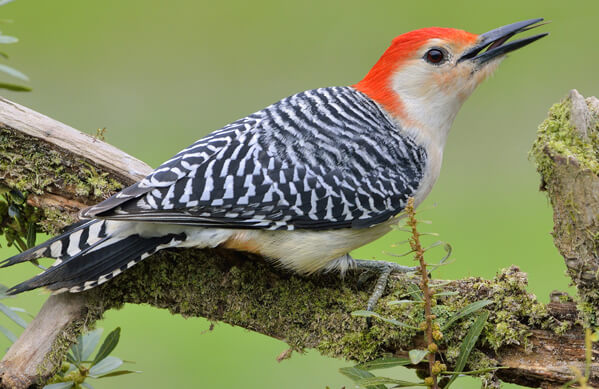Native Woodpeckers in Florida: A Guide to Types and Behaviors
Native Woodpeckers in Florida: A Guide to Types and Behaviors
Blog Article
Woodpeckers Unleashed: Exploring the Marvels of These Competent Tree Climbers
Woodpeckers, with their distinct markings and rhythmic drumming echoing via wooded locations, hold an one-of-a-kind location in the avian globe - Woodpeckers in Florida. As we dig into the detailed details of woodpeckers' nesting habits, feeding strategies, and the ongoing conservation initiatives to safeguard these remarkable birds, a much deeper recognition for their location in nature unravels.
Makeup and Adaptations
When examining the makeup and adaptations of woodpeckers, one can observe exceptional functions that enable these birds to thrive in their specialized ecological particular niche. In addition, woodpeckers have zygodactyl feet, with two toes dealing with onward and 2 encountering backwards, providing a company hold on tree trunks while they search for food or drum for interaction.
Moreover, woodpeckers have an unique tongue framework that is long, barbed, and sticky, allowing them to extract insects from crevices in timber. This specialized adaptation allows woodpeckers to make use of a food resource that is hard to reach to many other bird varieties. In general, the makeup and adaptations of woodpeckers display the impressive evolutionary services that have allowed these birds to grow in their arboreal habitat.
Drumming Actions
Having actually explored the anatomy and adaptations of woodpeckers, the emphasis currently shifts to comprehending their drumming habits, an unique facet of their interaction and territorial screens. Drumming is an important form of communication amongst woodpeckers, offering multiple objectives such as developing territories, bring in mates, and signaling alarm. Each woodpecker varieties has a distinct drumming pattern that helps individuals acknowledge members of their own varieties and distinguish them from competitors or predators.
Woodpeckers produce drumming audios by quickly pecking on resonant surface areas such as dead trees, energy poles, or perhaps steel objects, developing a collection of rhythmic beats. The intensity and speed of drumming can vary based on the objective; as an example, a fast drumming sequence may represent aggression towards intruders, while a slower and softer drumming pattern can indicate courtship (Woodpeckers in Florida). Furthermore, woodpeckers may readjust the regularity and duration of their drumming to communicate details messages efficiently
Nesting Behaviors
Discovering the nesting behaviors of woodpeckers exposes fascinating insights right into their reproductive habits and environment options. Woodpeckers are known for their unique nesting preferences, typically digging deep into dental caries in trees to create sheltered rooms for raising their young. These tooth cavities offer not just as a nesting website but additionally as a secure refuge from predators and stormy climate.
Woodpeckers show a high degree of fidelity to their nesting websites, frequently going back to web link the same location year after year. This habits highlights the significance of appropriate habitat availability for their reproductive success. The selection of a nesting website is vital for woodpeckers, with factors such as tree species, height, and decay phase playing considerable functions in their decision-making procedure.
Interestingly, some woodpecker types are understood to excavate multiple cavities within their territory, providing themselves with alternative nesting choices. This approach may act as a form of insurance versus possible risks or disruptions to their key nesting website.

Feeding Strategies
Woodpeckers use a variety of specialized feeding methods to obtain their primary food sources. Among one of the most distinctive feeding habits of woodpeckers is drumming, which involves quick pecking on trees to reveal pests below the bark. This drumming not only assists them situate prey but likewise acts as a method of interaction with other woodpeckers. Woodpeckers have solid, chisel-like beaks that allow them to drill right into timber easily. As soon as an opening is created, they utilize their long, barbed tongues to remove bugs such as ants, beetles, larvae, and spiders. These tongues are covered with sticky saliva that helps trap the victim. Woodpeckers are additionally understood to excavate dental caries in trees to accessibility concealed insect larvae or sap. Some types, like the acorn woodpecker, shop nuts in specifically developed holes called granaries. This calculated storing of food aids them endure throughout food shortage durations. Woodpeckers are really impressive in their feeding techniques, showcasing versatility and intelligence in obtaining their nourishment.
Preservation Efforts
In the middle of the elaborate feeding methods showed by woodpeckers, the preservation efforts targeted at protecting these interesting birds play a vital duty in preserving their environments and populaces. Woodpeckers deal with numerous risks to their survival, including environment loss because of logging, climate change altering their ecological communities, and collisions with synthetic frameworks such as structures and automobiles - Woodpeckers in Florida. Guardians are proactively functioning to deal with these difficulties and make certain the long-lasting wellness of woodpecker types

Education and learning and public awareness campaigns are likewise crucial components of woodpecker preservation initiatives. By increasing understanding about the helpful resources significance of these birds in keeping healthy and balanced woodland environments, conservationists can garner assistance for environment conservation campaigns and advertise accountable land administration techniques. With collective initiatives in between scientists, policymakers, and neighborhood neighborhoods, we can work together to protect a future where woodpeckers thrive in their all-natural habitats.
Final Thought

Report this page